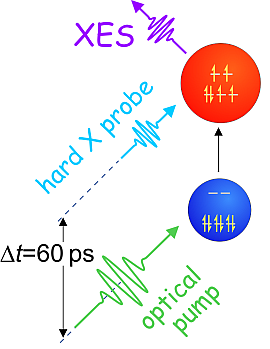On the microscopic origin of the nanoscale magnetic-electronic phase separation in LSCO
Investigating the roots of a nanoscale magneto-electronic phase separation (responsible for their magnetoresistance as well as cooperative electric and magnetic phase transitions) in bulk Sr-doped LaCoO3 (LSCO), we have combined local spectroscopic techniques as synchrotron XES and laboratory Mössbauer spectroscopy to identify and characterize the clusterization process. A simple model based on the random distribution of the doping Sr ions describes well both the doping-driven evolution of the separated phases and the variation of the Co spin state.
Read paper "Microscopic origin of the nanoscale magnetic-electronic phase separation in LSCO" at Phys. Rev. B 88 (2013) 035125 by Z. Németh et al.

Does nuclear resonant scattering violate reciprocity?
The physical term `reciprocity' has been first mentioned by Stokes (1849) and by numerous publications since then [Potton, Deák]. It expresses the requirement that upon the interchanging the source and detector in a scattering experiment the scattering amplitude remains unchanged. As a matter of fact, reciprocity is not necessarily fulfilled.
We have realized a (magnitude) reciprocal and (magnitude) non-reciprocal arrangements of magnetized 57Fe foils, which showed neither time reversal nor 180° rotational symmetry. Using nuclear resonant scattering of synchrotron radiation (at the ID22 beam line of ESRF;, Grenoble), in certain field geometries, full reciprocity, in others three orders of magnitude non-reciprocity were experimentally observed, (see figure) in full agreement with our theoretical expectations [Deák] demonstrating that the magnetooptical Faraday effect does not always lead to non-reciprocity. Further applications in gamma-optics are expected, since non-reciprocal devices are important class of optical components.
Read paper "Switching Reciprocity On and Off in a Magneto-Optical X-Ray Scattering Experiment Using Nuclear Resonance of α–57Fe Foils" in at Phys. Rev. Lett. 109, (2012) 237402

Ultrafast spin state determination:
A 665-ps-lived transient of the light-excited [Fe(bpy)3]2+ were recently observed to show geometry variations that correspond to excitation to a high-spin state, here we directly determine the spin momentum of FeII as S=2 with spin-sensitive ultrafast x-ray emission spectroscopy. The technique can also be utilized to element selective studies of the electronic structure in femtochemistry experiments at bright femtosecond (future) X-ray sources.
Read the paper "Picosecond Time-Resolved X-Ray Emission Spectroscopy: Ultrafast Spin State Determination in an Iron Complex" at Angewandte Chemie Int. Ed. 50 (2010) 5306–5309 by G. Vankó, P. Glatzel, Ch. Bressler et al.

Intermediate-spin ferrous iron in lowermost mantle post-perovskite and perovskite
Iron-bearing silicate post-perovskite and perovskite are believed to be the dominant minerals of the lowermost mantle and the lower mantle, respectively. The electronic spin state of iron—a quantum property of every electron associated with its angular momentum—can strongly influence the properties of these mineral phases and thereby the nature of the Earth's interior. However, the spin state of iron at lowermost-mantle pressure/temperature conditions is poorly known. Here we use in situ X-ray emission, X-ray diffraction and synchrotron Mössbauer spectroscopic techniques to measure the spin and valence states of iron in post-perovskite and perovskite at conditions relevant to the lowermost mantle. We find that Fe2+ exists predominantly in the intermediate-spin state with a total spin number of one in both phases. We conclude that changes in the radiative thermal conductivity and iron partitioning in the lowermost mantle would thus be controlled by the structural transition from perovskite to post-perovskite, rather than the electronic transition of Fe2+.
Read the paper at Nature Geoscience DOI:10.1038/ngeo310 by J.F. Lin, G. Vankó et al.

Perturbative theory of grazing-incidence diffuse nuclear resonant scattering of synchrotron radiation
Theoretical description of off-specular grazing-incidence nuclear resonant scattering of synchrotron radiation (synchrotron Mössbauer reflectometry, SMR) is presented. The recently developed SMR, similar to polarized neutron reflectometry (PNR), is an analytical tool for the determination of isotopic and magnetic structure of thin films and multilayers. It combines the sensitivity of Mössbauer spectroscopy to hyperfine interactions and the depth selectivity of x-ray reflectometry. Specular reflection provides information on the depth profile, while off-specular scattering on the lateral structure of scattering layers. Off-specular SMR and PNR intensity formulas of a rather general multilayer with different domains, based on a distorted incident-wave approximation (DIWA), are presented. The distorted-wave Born approximation results are given in an appendix. Physical and numerical implications, of using DIWA are explained. The temporal character of SMR imposes specific differences between SMR and PNR. In order to reveal the limits of DIWA and to compare the two analytical methods, two-dimensional diffuse SMR and PNR maps of an antiferromagnetic multilayer are calculated and critically compared. Experimental “omega−2theta” SMR map of a periodic [Fe/Cr]20 multilayer is presented and compared with simulations by the present theory.
Read the paper

(image featured in the PRB Kaleidoscope)
Spin Transition Zone in Earth's Lower Mantle
Mineral properties in Earth’s lower mantle are affected by iron electronic states, but representative pressures and temperatures have not yet been probed. Spin states of iron in lower-mantle ferropericlase have been measured up to 95 gigapascals and 2000 kelvin with x-ray emission in a laser-heated diamond cell. A gradual spin transition of iron occurs over a pressure-temperature range extending from about 1000 kilometers in depth and 1900 kelvin to 2200 kilometers and 2300 kelvin in the lower mantle. Because low-spin ferropericlase exhibits higher density and faster sound velocities relative to the high-spin ferropericlase, the observed increase in low-spin (Mg,Fe)O at mid-lower mantle conditions would manifest seismically as a lower-mantle spin transition zone characterized by a steeper-than normal density gradient.
For more, read the paper Spin Transition Zone in Earth's Lower Mantle

Hard X-ray Induced Excited Spin-State Switching (HAXIESST)
At low temperatures, an intense beam of hard X-rays excites photoswitchable molecular spin-crossover systems to generate metastable high-spin states. These states have spectroscopic properties similar to those of the states generated by light-induced excited-spin-state trapping (LIESST). The new approach offers an excitation source with greater penetration.
Read more about HAXIESST in the Angewandte Chemie Int. Ed. paper or in our contribution to the ESRF Highlights.



